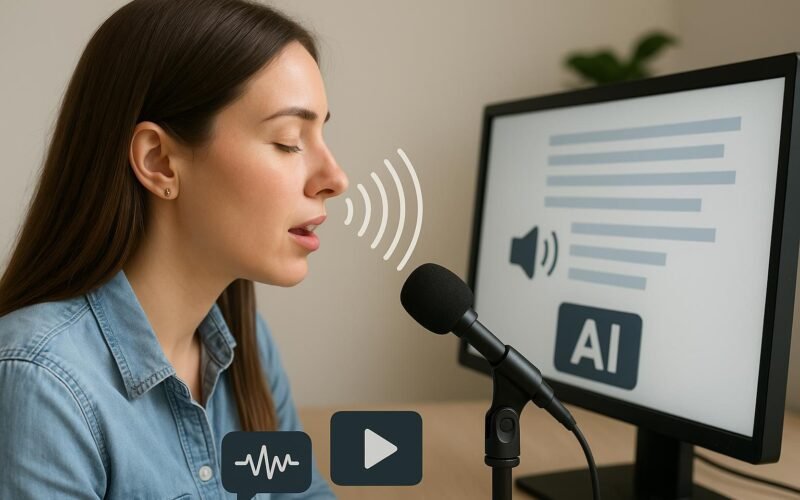Introduction
In recent years, AI text-to-speech (TTS) technology has seen rapid advancement, driven by the broader evolution of generative AI. These tools are increasingly used across marketing, corporate communication, entertainment, and content creation to convert written text into natural-sounding speech.
Whether you’re developing voiceovers for promotional videos, e-learning modules, audiobooks, or social media content, realistic AI voices can enhance the viewer’s experience, boost engagement, and reduce production costs. As cloud migration and automation simplify digital workflows, TTS tools have emerged as powerful solutions to time-consuming voiceover tasks. AI not only automates but also problem-solves, bridging the gap between scalable content creation and high-quality output.
This article explores five of the best AI TTS tools online that offer high-quality, natural voice synthesis. These tools vary in features, voices, and use cases, making it easier for users to select one that fits their specific needs.
1. Invideo AI
Invideo AI stands out as a robust, user-friendly platform that helps creators convert text into lifelike voiceovers with ease. Whether you’re working on marketing videos, corporate presentations, entertainment content, or social media reels, Invideo AI’s text-to-speech AI free tool delivers high-quality results.
The platform supports 50+ languages and accents, offering a wide variety of realistic male, female, young, and mature voices. You can either use your own voice or choose from their rich library, which makes it perfect for global content strategies.
Invideo AI is particularly effective for video creators looking to add human-like intonations, tonal variations, and local accents to their videos. The voiceovers it generates sound remarkably natural, helping to hold viewer attention and boost engagement, whether it’s a short-form video on TikTok or a long explainer video on YouTube.
Features:
- Realistic AI voice generation
- 50+ languages and accents
- Customizable tone, pitch, and speed
- Built-in AI video generator for seamless content creation
- Ideal for corporate content, Instagram, TikTok, and YouTube.
Use Cases:
- Marketing campaigns
- Product explainer videos
- Internal communications
- Social media voiceovers
- Corporate training modules
Invideo AI’s integrated workflow from text input to full video output gives it a considerable edge, especially for users who want all-in-one AI voiceover and video solutions.
2. PlayHT
PlayHT is a solid AI text-to-speech platform designed for creators and developers seeking quality and speed. The platform supports numerous languages and offers both standard and ultra-realistic voices based on deep learning models.
What sets PlayHT apart is its clean interface and voice styles that are customizable for tone, emotion, and speed. You can use PlayHT for narrations, podcasts, or interactive learning materials, with features that allow easy export and integration into other platforms.
Features:
- 100+ voices in multiple languages
- Emotional tone adjustments
- Audio export in MP3 and WAV formats
- Embeddable audio players
Use Cases:
- Podcasts
- News narration
- Web content voiceovers
While PlayHT lacks a native video editor, it still fits well for content creators who primarily focus on voice generation.
3. Lovo.ai
Lovo.ai is geared toward creatives in the entertainment and e-learning sectors. With a focus on expressive voices, Lovo enables users to produce human-like narration quickly. Its interface supports script import, audio preview, and fine-tuning for a smooth user experience.
What’s notable is Lovo’s offering of voice styles like cheerful, serious, or sad, which are ideal for storytelling and character-driven content. It also includes voice cloning as an advanced feature for those looking to customize further.
Features:
- 180+ voices
- Voice styles and emotions
- Script importing and preview
- Basic audio editing tools
Use Cases:
- Audiobooks
- Character dialogue
- Educational content
Lovo’s performance is well-aligned with creators needing variety and emotion in their voiceovers, particularly for long-form projects.
4. Murf.ai
Murf.ai offers a strong suite of features tailored for professionals who need polished voiceovers for business and training content. Its standout feature is voice customization combined with collaboration tools, making it ideal for team-based projects.
Murf’s interface allows for voiceover timing, sync with slides, and collaborative review, making it one of the better platforms for corporate training videos and internal documentation.
Features:
- Studio-like voice recording environment
- Team collaboration tools
- Voice timing and synchronization
- Google Slides integration
Use Cases:
- E-learning modules
- Corporate presentations
- Training and onboarding videos
Although Murf is feature-rich, it may feel a bit complex for casual users or social media creators looking for quick results.
5. Voicemaker
Voicemaker is a simple yet capable tool for quick AI voice generation. It supports a wide range of voices and languages, with basic control over speech rate, pitch, and volume. While it’s not as advanced as other tools on this list, it’s a good option for those who need a straightforward, budget-friendly TTS generator.
The UI is no-frills, but the tool is efficient and delivers natural-sounding output suitable for basic use cases like announcements, demo videos, and e-learning audio.
Features:
- Wide language support
- Easy-to-use interface
- Download in MP3 or WAV
- SSML support for detailed control
Use Cases:
- Product walkthroughs
- Voice alerts and notifications
- Basic YouTube content
Voicemaker is best suited for users who want a quick voiceover solution without investing in a broader content creation suite.
Conclusion
AI text-to-speech tools are no longer basic robotic narrators. Today, they are intelligent systems capable of generating realistic, expressive voices that suit diverse applications from marketing videos to training materials. With cloud-based AI problem-solving capabilities, these tools make it easier to scale content without sacrificing quality or tone.
Among the list, Invideo AI clearly leads for those who want both high-quality voiceovers and video production in one platform. Meanwhile, others like PlayHT and Murf.ai offer specialization for developers and corporates, respectively.
Choosing the right tool depends on your project needs, whether it’s quick social media voiceovers or polished e-learning modules.
FAQs
- What is AI text-to-speech?
AI text-to-speech (TTS) uses artificial intelligence to convert written text into spoken audio using natural-sounding voices.
- Which tool is best for social media voiceovers?
Invideo AI is highly suitable for social media content due to its AI-integrated video and voiceover capabilities.
- Can I get realistic voices for free?
Yes. Some tools, like Invideo AI’s text-to-speech AI free tool, offer basic access to natural-sounding voices without cost.
- Are these tools suitable for professional projects?
Absolutely. Tools like Murf.ai and Lovo.ai cater to professional use cases, including corporate and educational content.
- Do these platforms require downloads?
Most are cloud-based and run fully online, requiring no software installation.






